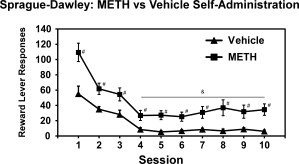The following paper, continuing our investigations into the substituted cathinone stimulants, has been accepted for publication published (Sep 2013):
Aarde, S.M., Angrish, D., Barlow, D.J., Wright, Jr., M.J., Vandewater, S.A., Creehan, K.M., Houseknecht, K.L., Dickerson, T.J. and Taffe, M.A. Mephedrone (4-methylmethcathinone) supports intravenous self-administration in Sprague-Dawley and Wistar rats. Addict Biol, 2013, 18(5):786-799. [ PublisherLink ]
The drug mephedrone, sometimes called MMCAT or “plant food”, became highly popular in the UK in 2009-2010 and user reports variously compare it to 3,4-methylenedioxymethamphetamine (MDMA) and cocaine, as well as other psychomotor stimulants. The similarity to MDMA was reinforced by three neurochemical findings showing a very MDMA-like pattern of relatively greater serotonin vs dopamine accumulation in the nucleus accumbens using microdialysis techniques (see here, here for discussion).
The takeaway message from this new paper is that 4-methylmethcathinone (4-MMC; mephedrone) is readily self-administered, intravenously, by rats using conditions that are fairly typical of the usual stimulant self-administration paradigms. Our experiments were conducted in 1 hour sessions under normal laboratory ambient temperature conditions (about 24 °C). The only other data available in the published literature at present (Hadlock et al, 2011; see this post) involved 4 hour sessions conducted at 29 °C, both of which conditions might be predicted to elevate intake in rats.
 In this portion of a figure from the paper we show that male rats of two different strains (Wistar and Sprague-Dawley) common to self-administration experiments maintain stable reward lever pressing (and therefore intakes of 4-MMC) within about 10 sessions. This was the case for two different amounts of drug delivered in each infusion that the animal obtained by lever pressing. In this experiment animals were previously trained to respond on the lever for food pellets under an FR5 response contingency which was continued in the self-administration phase, thus every 5 responses resulted in a drug infusion.
In this portion of a figure from the paper we show that male rats of two different strains (Wistar and Sprague-Dawley) common to self-administration experiments maintain stable reward lever pressing (and therefore intakes of 4-MMC) within about 10 sessions. This was the case for two different amounts of drug delivered in each infusion that the animal obtained by lever pressing. In this experiment animals were previously trained to respond on the lever for food pellets under an FR5 response contingency which was continued in the self-administration phase, thus every 5 responses resulted in a drug infusion.
 By way of comparison, additional groups of Sprague-Dawley rats were trained similarly and then permitted to obtain d-methamphetamine (0.05 mg/kg/infusion) or only the saline vehicle. This latter group is necessary to rule out the possibility that the animals are continuing to seek the food pellets used in the pre-training interval. As is readily apparent, 4-MMC and methamphetamine maintain a mean of about 30 responses per session whereas saline substitution results in very low levels of lever pressing.
By way of comparison, additional groups of Sprague-Dawley rats were trained similarly and then permitted to obtain d-methamphetamine (0.05 mg/kg/infusion) or only the saline vehicle. This latter group is necessary to rule out the possibility that the animals are continuing to seek the food pellets used in the pre-training interval. As is readily apparent, 4-MMC and methamphetamine maintain a mean of about 30 responses per session whereas saline substitution results in very low levels of lever pressing.
Under these conditions, methamphetamine and 4-MMC have about equal effect on rat self-administration although the 4-MMC is considerably less potent, requiring about 10 times the per-infusion dose for effect. This is consistent with the emerging in vitro and behavioral pharmacological literature, which shows a similar reduced potency of 4-MMC relative to methamphetamine.
Although we don’t show it directly in this paper, MDMA is at best unevenly self-administered by rats. The literature reflects some successes in establishing self-administration of MDMA but the effects are inconsistent across laboratories, lower fractions of the subjects acquire the behavior, session-to-session intake is less consistent, etc. We found no evidence of this in the present study and conclude that despite a MDMA-like serotonin/dopamine neuropharmacological effect, 4-MMC has a liability for repetitive intake more similar to the classical amphetamine-type stimulants such as methamphetamine.
[…] an uncertain reinforcer in rodent IVSA compared with the more typical amphetamines. Mephedrone is much more readily self-administered than MDMA and a single prior report seemed to indict that methylone […]
Pingback by Mephedrone is more reinforcing than methylone or MDMA in female rats | TL neuro — January 9, 2015 @ 9:27 am